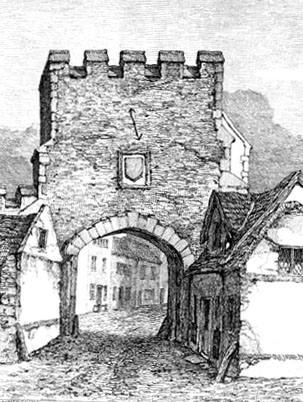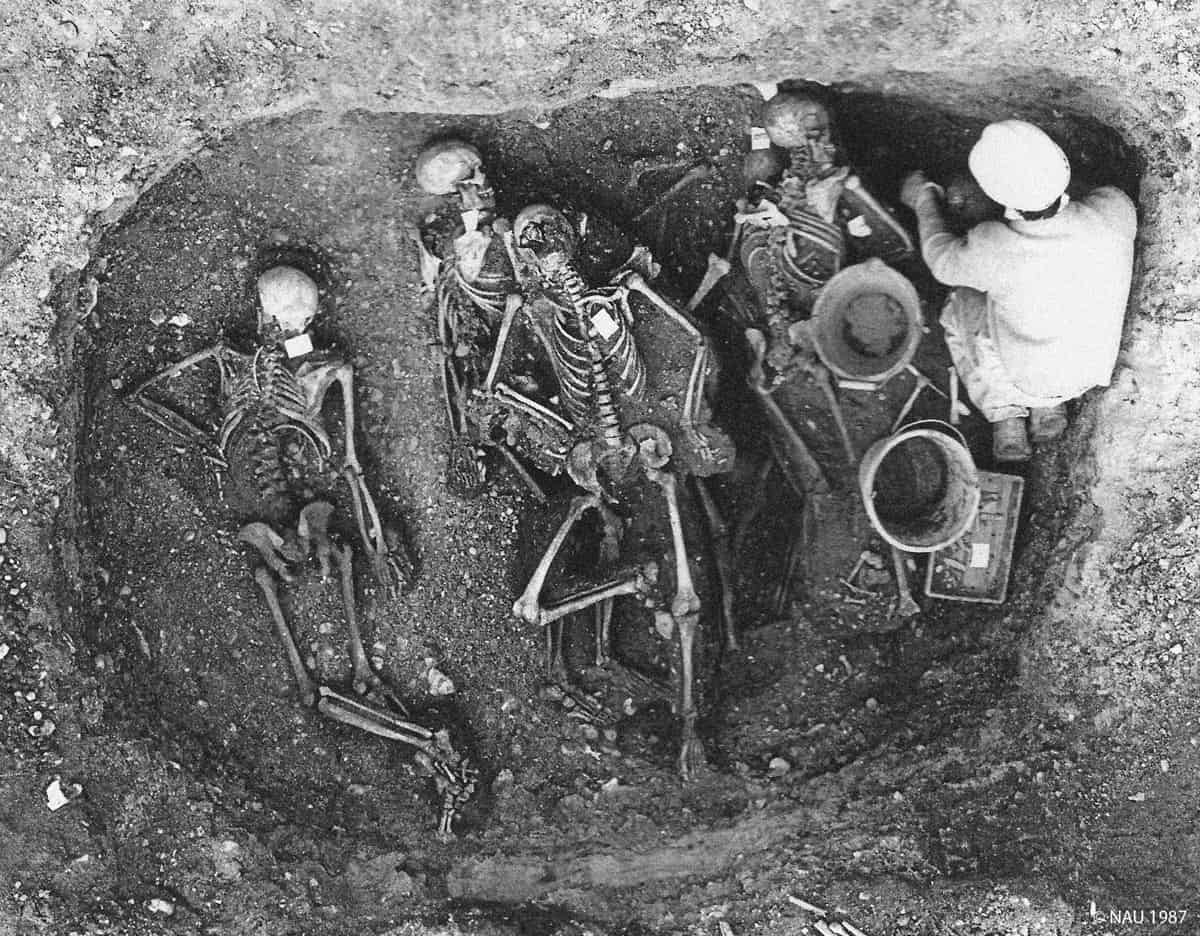Magdalen Street’s hidden history:
The lost churches Part 3, St Margaret.
About thirty years ago, there was a little club in Magdalen Street; a brilliant grubby little hand-me-down from the age of jazz, blues and skiffle. It sat towards the end of Magdalen Street covered a distinct hole in the market for the beer drinking, flailing youth of Norwich and Norfolk who didn’t like flicks, pastel Ben Sherman shirts, and creases in their chinos. It had provided a refuge for the less inclined to toe the accepted line for a good few years before. Originally the White Lion; a pub which during the era of Black Anna and the Jolly Butchers was bought by Albert Cooper and his brother who turned it into The Jacquard. It had become one of the few homes to the alternative music scene in Norwich from then on and despite being sold with the name intact in the late 1970s and burning down in the early 1990s, continued to serve as a hole for the square pegs to bang themselves into.
The conversion to punk and new wave didn’t take long, barely a blink. It fast became a regular venue for the spiky-haired brigade along with the Boogie House and the Gala Ballroom. It lasted for more than ten years as that before it eventually gave up and became flats. It was a seriously good little club in its heyday, no dress code, very few casual wanderers ever assaulted it from the more mainstream end of Magdalen Street which catered for the more ironed and gelled, and less crimped and lacquered sections of youth culture. It was a dark, steaming, writhing mass of all that is great about liking music most people don’t, elbow-bashing dancing and mass Breaker drinking, a cigarette and fug so thick you could only cut it with a decent mohican. It would blare on until we were sweaty, drunk and exhausted, throats sore from shouting over the top of The Men They Couldn’t Hang, The Circle Jerks, New Model Army, Death Cult and Bauhaus. We’d be belched out into the night on a breath of beer and fags to stumble off to the bench opposite to sit and finish the last can and have a final gasper before heading off home, past the other clubs as they vomited out their equally drunk slightly more pastel cargo.
At 2am, as we sat on that bench opposite with overspill bodies on the pavement in front of the hoardings or later the picket fence in front of a piece of wasteland, some of which had until recently been shops and part of the old bombed-damaged Blind Institute. It was just a piece of rough ground, worthy of mainly ignoring, it wasn’t until years later I realised a Nick Cave-esque secret lurked under it. Like a dream, some amphetamine logic in a fevered goth’s mind.
 In 1987, the Norfolk Archaeological Unit (NAU) started a huge dig on the site, one that would be complex and rewarding, and end up being a proving ground for the solidification of various theories about how death dealt its cards to the paupers and criminals of Norwich and England from the 12th to the 15th century. It is the site of Sancta Margarete Fybriggate in Combusto or St Margaret Fybriggate in the burnt area. This directly relates to another period in the history of the street; the sacking of Norwich in 1004 by Sweyn Forkbeard and his band of merry amoral filed teeth whackjobs, chances are it would have almost certainly been a wooden chapel at that point and would have made a nice bonfire to run about shouting things in old Norse. It would have later been rebuilt in stone and flint. It also had the slightly less attractive name of St Margaret Ubi Sepeliunter Suspensi, or St Margaret where the hanged men are buried. It is in the general scheme of things historically a poor part of the city, so the position of being the place to plant the results of the gallows was probably foisted on the parish if there was any return either pocketed by the church or to the parish itself we will never know. Fyebriggegate itself would have hosted a percentage of the hangings at what is now Magdalen Gate, the remains of the wall it was attached to still sit next to that lump of flint next to the busy Bull Close and Magpie Road junction, a victim of 18th Century clearances, only recorded in a handful of sketches and etchings remain of the gate.
In 1987, the Norfolk Archaeological Unit (NAU) started a huge dig on the site, one that would be complex and rewarding, and end up being a proving ground for the solidification of various theories about how death dealt its cards to the paupers and criminals of Norwich and England from the 12th to the 15th century. It is the site of Sancta Margarete Fybriggate in Combusto or St Margaret Fybriggate in the burnt area. This directly relates to another period in the history of the street; the sacking of Norwich in 1004 by Sweyn Forkbeard and his band of merry amoral filed teeth whackjobs, chances are it would have almost certainly been a wooden chapel at that point and would have made a nice bonfire to run about shouting things in old Norse. It would have later been rebuilt in stone and flint. It also had the slightly less attractive name of St Margaret Ubi Sepeliunter Suspensi, or St Margaret where the hanged men are buried. It is in the general scheme of things historically a poor part of the city, so the position of being the place to plant the results of the gallows was probably foisted on the parish if there was any return either pocketed by the church or to the parish itself we will never know. Fyebriggegate itself would have hosted a percentage of the hangings at what is now Magdalen Gate, the remains of the wall it was attached to still sit next to that lump of flint next to the busy Bull Close and Magpie Road junction, a victim of 18th Century clearances, only recorded in a handful of sketches and etchings remain of the gate.
The dig revealed very little of the church, a possible section of what could be the East wall, the overbuilding of the site particularly the cellars of the blind institute have removed any real evidence of the building in the 1800s. The impoverished nature of the parish would have probably meant it was originally a small wooden building overbuilt in flint rubble, probably thatched and quite simple – similar to St Botolph on the other side of the old defensive bank and ditch just to the South under the Anglia Square offices, That is about as much as we can gain from what the ravages of the past has left of the previous past.
What is interesting about the site is the sheer number of skeletons recovered; over 1a thousand, 436 of these were articulated, so not just scattered bones, of these 413 were complete enough for examinations of entire bodies and all the information that this brings to the table. Plus there was charnel scatter both in and under the modern topsoil.
Interesting, interesting, interesting…
But what makes it extraordinary are the finding made based on study of the bones. To start with the size of the subjects against other samples; comparatively 2cm shorter than sailors bones of a similar era, suggesting poorer food or perhaps rather better food provision on a boat under the Crown. There are of course the oddly positioned, aligned and prone burials of the executed, also numerous examples of head trauma, not necessarily the cause of death in most cases, some may be the result of accident, but there is a strong likelihood that some of the inhabitants of the area had been involved in either the Hundred Years War or the First English Civil War and survived it with wounds that healed, consistent with a blow to the head with a sword or a blade.
The range of disease is astounding too, from Leprosy and Syphilis to Tuberculosis, additionally a high level of Spina Bifida and instances of both Osteoarthritis and Spondylolysis. In addition deficiency diseases such as Scurvy and Rickets. There are two instances of fairly severe disability, in one particular case a possible Cerebral Palsy sufferer, both are in adult subjects; as Stirling suggests in the report on the palaeopathology study of the site’s human remains this is perhaps indicative of the nature of a poor but socially sophisticated parish; a community made up of families that cared and looked after each other making sure the infirm and challenged had a full and long-life not just some brief existence discounted by society. Next time something is described as ‘positively medieval’ we should perhaps look at some of the ways today’s society via our elected government treats people now and focus an eye on that little distant and slightly indistinct positive point in the past.
It has of course, as is the nature of a living city, been wholeheartedly built over, now Throckmorton Yard complete with YMCA accommodation, required parking and bin areas lives over it, wedged in to an area of Victorian and mixed modern shopfronts, near a lost city gate on an old road to the coast.
The whole series of articles are available here:
Part 1 – Magdalen Street hidden history, the lost churches
Part 2 – St Botolph the Traveller
Part 3 – St Margaret: Beating the demons
Part 4 – St Mary Unbrent
Part 5 – St Paul
Part 6 – All Saints Fybriggate
References: EAA 129, NAU Arch and NHE. Anne Stirland.
The Medieval Churches of Norwich, Nick Groves.
Thanks to Lorna Richardson for the loan,
This ones for Pinky, a Breaker on the bench.


![Magdalen St 132 Blind Institute [4908] 1965-05-19](https://www.invisibleworks.co.uk/wp-content/uploads/2014/05/Magdalen-St-132-Blind-Institute-4908-1965-05-19-1024x684.jpg)

I remember being on that dig as I was between exams at school. And I certainly remember uncovering two skeletons and gently brushing away the dirt to reveal they where hand in hand. Some of them had been buried face down and I can only presume they may have been criminals. You’re right about the head traumas; there were quite a few with what can only be described as sword or axe wounds cut into their skulls
Has anyone heard the paranormal stories concerning Throckmorton Yard? Takes of mysteriously scratched doors and residents suffering from depression. Might just be pub banter and rumours…
Well I’ve lived in Throckmorton Yard 20years and the only strange goings on I’ve encountered have been down to the living not the dead nor have I heard of anything but who knows…..
I’ve just started researching lost churches of Norwich for an illustration project. It is so fascinating to me, but the bit that has got me really crazy is the fact that I live in Throckmorton Yard. I live above a burial ground of angry and lost souls. Sickeningly I am very very excited about this.
Huh. I walked past there just yesterday.
Nice to know there are other people into all this!
(You know a LOT more than I do, and I’ve lived here a while – I’m more a musician than a researcher but, like I say, it’s nice to know where to come to find out more – your blog!)
I don’t photograph nearly as well, either, but I’m trying haha!
What a great distraction this has been – not only loved your description of the jacquard but having grown up on Waterloo rd i find the history fascinating and yes who would’ve believed that the bench and hoardings hid such a secret!
Fascinating post – as always – thank you Nick.
Would love to know if those skeletons had full DNA examinations – and what new techniques would uncover about the people – including their ancestry (ethnic heritage) and their relationship with each other and with people now living.
Cheers
H
@HuwSayer
Fascinating stuff Nick, love the description of the jacquard, spot on !!
Strange to come across my image from my first full time job with NAU as site photographer, a role I carried on with, almost continuously until May 1991 when I moved to the then Norwich School of Art and Design as the Slide Technician. I’m still there, now as the Resources Manager for Norwich University of the Arts (since 2005). The excavator working in the burial pit is a youthful Tim Pestell, nowadays Dr Tim Pestell, Curator of Archaeology at Norwich Castle Museum.
Thanks for an interesting article.